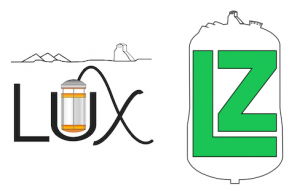
Liquid xenon time projection chambers are a proven mature technology for dark matter detection, focusing on the favored dark matter mass range of a few GeV/c2 and above. This technology’s main strengths could be listed as
- multiple signal channels per recoil event (scintillation and ionization)
- a high level of self-shielding of external backgrounds (paired with precise position information)
- extreme radio-purity and continuous purification
- a high-nucleon-number nucleus, enhancing the coherent elastic recoil cross-section
The Hertel Group contributes to two such liquid xenon efforts, the LUX experiment and its successor the LZ experiment. The LUX experiment has lead the world in sensitivity to the most favored dark matter models; LZ will improve on this sensitivity by multiple orders of magnitude, with a start of science data in 2020. Both projects are located at the Sanford Underground Research Facility nearly one mile underground. Our group plays a central role by calibrating these detectors using radioactive gases that mix with the liquid xenon itself.
LUX public page LZ public page
